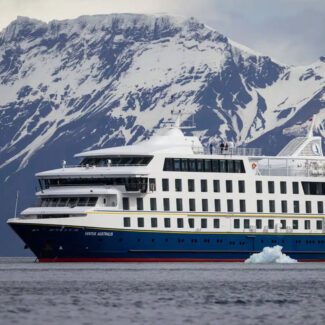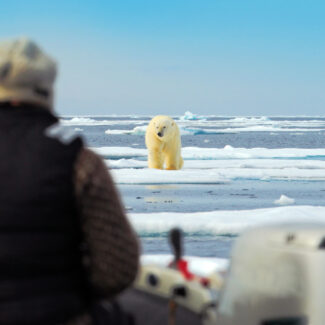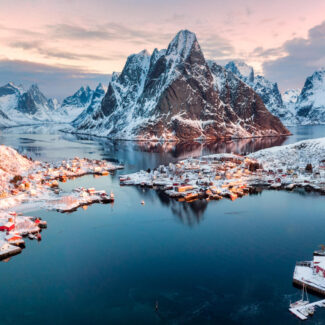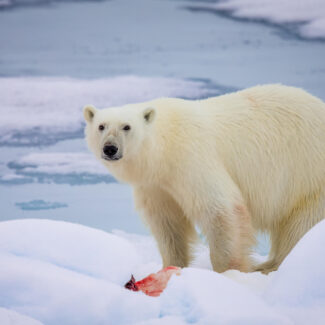The Volcanoes Of Antarctica: Active & Abundant
Icebergs, penguins, the blank white void of the South Pole, sure, but volcanoes likely aren’t the first thing to come to mind for your average person when it comes to Antarctica. Yet volcanic activity very much helps define much of the Antarctic realm, and indeed this gloriously remote land is one of the best places in the world to do fieldwork as a volcanologist.
Many of Antarctica’s (mostly inactive) volcanoes are buried in ice or well off the tourist path, but you can definitely see some of these fire mountains or associated rock formations on a typical cruise. In this article, we’ll explore some of the background of volcanism in and around Antarctica, profile some of this realm’s most notable volcanoes, and detail how you can go about seeing some of this dramatic geology firsthand on a bucket-list getaway to the White Continent.
Are There Volcanoes in Antarctica? The White Continent’s Volcanic Heritage
Antarctica constitutes the planet’s greatest glaciovolcanic zone, where volcanoes erupt from or even under ice cover. This magma-ice interplay, seen in more restricted and isolated fashion in some other parts of the world, is a defining and fascinating feature of Antarctic volcanism. Geologists also flock here because Antarctica’s volcanoes, unlike many elsewhere, aren’t obscured by vegetation.
The White Continent has seen quite the diversity of volcanic activity over its long evolution. Several hundred million years ago, it belonged to the supercontinent Gondwana (or Gondwanaland), which also encompassed the other modern-day continents of the Southern Hemisphere. As Gondwana began to break up some 180 million years ago, rifting generated voluminous quantities of basaltic lava: flood (or plateau) basalt, so-named for the fluid molten rock’s propensity to spread over large areas through extended and repeated eruptive cycles. The flood basalts of the Ferrar Magmatic Province or Ferrar Group, which include the well-known Kirkpatrick Basalt of the Transantarctic Mountains, have been linked to similar formations in southern Africa and beyond, summoning the ancient kinship of the southern continents and that drawn-out, long-ago Gondwanan sundering.
West Antarctica and the boundary between it and the ancient, stable landmass of East Antarctica have hosted most of the White Continent’s volcanism. The subduction of oceanic plates under Gondwana’s Pacific margin some 200 million years ago fueled volcanic activity that helped build the Antarctic Peninsula, which is what geologists call a continental margin arc and whose mountains continue the north-south line established by the South American Andes. As Antarctica separated from South America several tens of millions of years ago, that subduction-related volcanism eased on the Antarctic Peninsula, while it continues to progress in the Andes.
Recent research confirms that one of the world’s largest volcanic provinces underlies Antarctica, connected to the West Antarctic Rift System that underlies the West Antarctic Ice Sheet and bumps up against the Transantarctic Mountains separating West and East Antarctica. We’ll dig into this intriguing realm next.
Beyond its icy façade, Antarctica boasts a surprising volcanic heritage! While not all mountains are volcanoes, this stunning vista of the Transantarctic Mountains hints at the continent’s dynamic geological past, reminding us of the powerful forces that shaped this unique frozen land.
The West Antarctic Rift System Volcanic Province
A mighty rift system similar to that of East Africa or the Basin-and-Range Province of the western U.S. lies under West Antarctica’s ice cover. The buried rift valleys—and the uplifted Transantarctic Mountains—mark a zone of extensive crustal thinning and pulling-apart along the boundary between the younger, hodgepodge tectonics of West Antarctica and the older, continental core of East Antarctica. This rifting appears to have begun around the dawn of the Cenozoic, our current geologic era, some 66 million years ago or so.
Recently active and active volcanoes in Antarctica are associated with the West Antarctic Rift System, which runs from the Antarctic Peninsula into the Ross Sea. How many volcanoes are in Antarctica? A 2017 study scrutinizing models of the terrain under the West Antarctic Ice Sheet identified nearly 140 probable subglacial volcanoes along the Rift System, 91 of which hadn’t been described previously, and some of which exceeded 12,000 feet in height.
The status of these volcanoes, active or not, isn’t fully known. And they likely have great significance in terms of the stability and mechanics of the West Antarctic Ice Sheet. The authors of that 2017 survey noted that, while volcanic activity along the Rift System isn’t likely the primary cause of the current decline of the West Antarctic Ice Sheet, it could influence ice-sheet dynamics in the future. Subglacial eruptions could certainly lead to more intense melting along the bottom of the ice sheet, and there’s also evidence—as from places such as Iceland—for increased volcanic activity as the “overburden” of ice sheets thins and disappears.
But the researchers also point out that the ruggedness of subglacial volcanic cones can help slow glacial movement as compared to smoother buried terrain. This might somewhat counteract increased rates of flow connected to the “runaway retreat” the West Antarctic Ice Sheet appears vulnerable to.
In short, how active volcanism in Antarctica interacts with ice-sheet dynamics remains an open area of research, and the mechanisms are likely pretty darn complicated.
Beneath Antarctica’s vast ice sheets lies a hidden world of volcanic activity, particularly within the West Antarctic Rift System Volcanic Province. While often unseen, the geological forces shaping these incredible icy landscapes, like the dramatic forms pictured, are a constant reminder of the continent’s fiery past and present.
Mount Erebus—the Most Active Volcano in Antarctica—and Ross Island
The southernmost active volcano on Earth—and the only known active volcano on the Antarctic mainland—is the great Mount Erebus. This ice-shrouded, 12,448-foot stratovolcano, formed atop a shield-volcano base and one of several volcanic edifices on Ross Island in the Ross Sea, is also simply one of the most dramatic and unique of its kind anywhere.
Erebus’s crown comprises a plateau created by a mostly filled-in caldera, and then a summit dome broken by a couple of craters. The largest of these summit craters, Main Crater, includes an inner crater that cradles a lava lake—one of the few known in the world.
Mount Erebus—which was first described in 1841 by Captain James Ross, who saw it erupting—is a rift volcano, and shares Ross Island with several inactive others. They include Erebus’s eastern neighbor, Mount Terror, which has variously been described as a stratovolcano or a shield volcano, and, forming Ross Island’s northwestern lobe, the Mount Bird shield.
Ross Island’s volcanoes lie along the West Antarctic Rift System (the Terror Rift, specifically), and a mantle plume has been posited as their direct cause.
Standing majestically on Ross Island, Mount Erebus is not only Antarctica’s most active volcano but also a stunning reminder of the continent’s fiery core. Its steaming crater, visible even from a distance, offers a dramatic contrast to the pristine white landscape, showcasing the dynamic geological forces at play.
Deception Island in the South Shetlands
Deception Island in the South Shetlands Islands is the Antarctic zone’s other well-documented active volcano, and one known for explosive eruptions in the recent past. This shield volcano with its open caldera forms a mesmerizing ring, entered (in unforgettable fashion) via Neptune’s Bellows. Marvel at its maars—special types of volcanic craters—including Whalers Bay, right inside the natural harbor, the name of which reflects this volcanic amphitheater’s history as a safe harbor for whaling ships.
Deception Island in the South Shetlands is a true geological marvel – a horseshoe-shaped caldera of an active volcano! Its unique landscape, featuring black volcanic beaches and steaming waters, offers a dramatic contrast to the typical Antarctic scenery and a fascinating glimpse into the continent’s fiery heart.
Gaussberg
Though your average Antarctic traveler will never see it, it’s worth mentioning the volcano Gaussberg: the only one of its kind along the East Antarctica coastline. This handsome—and intensely isolated—extinct volcano along the Davis Sea may owe its bygone “fires” to an errant mantle plume, though why it exists where it does isn’t settled.
Volcanoes of Antarctica: Viewing on Cruises
The most visited corner of Antarctica, the Antarctic Peninsula serves up plenty of volcanic sights. One classic example is Brown Bluff, a basaltic tuya—a flat-topped, mesa-like volcano erupted under an ice sheet—on the Tabarin Peninsula, a striking landform and also known for the penguin colony it backdrops.
A relatively few Antarctic cruises venture into the Ross Sea, but those that do commonly dock at Ross Island, serving up (unforgettable) views of Mount Erebus and its inactive neighbors.
Seeing a polar cone or tuya in person, or just marveling at them on the map not far beyond where your expedition’s foraying, is a thrill: a reminder of Antarctica’s fiery past—and, to some extent, its fiery present and future.
While not every landing site features an active volcano, many Antarctic cruises offer opportunities to view the continent’s volcanic landscapes from the ship or during shore excursions. Witnessing diverse terrain like this, from penguin colonies to stunning ice formations, hints at the fiery geological forces that continue to shape this abundant and icy realm.
Disclaimer
Our travel guides are for informational purposes only. While we aim to provide accurate and up-to-date information, Antarctica Cruises makes no representations as to the accuracy or completeness of any information in our guides or found by following any link on this site.
Antarctica Cruises cannot and will not accept responsibility for any omissions or inaccuracies, or for any consequences arising therefrom, including any losses, injuries, or damages resulting from the display or use of this information.







